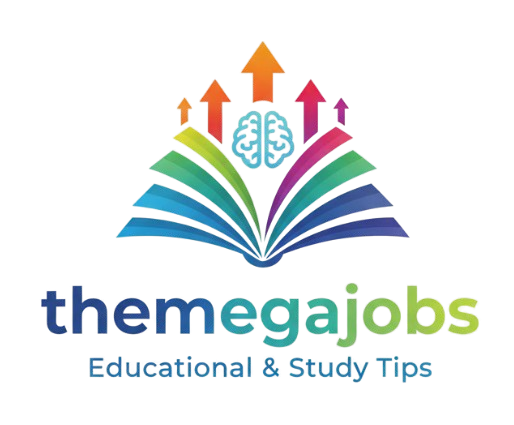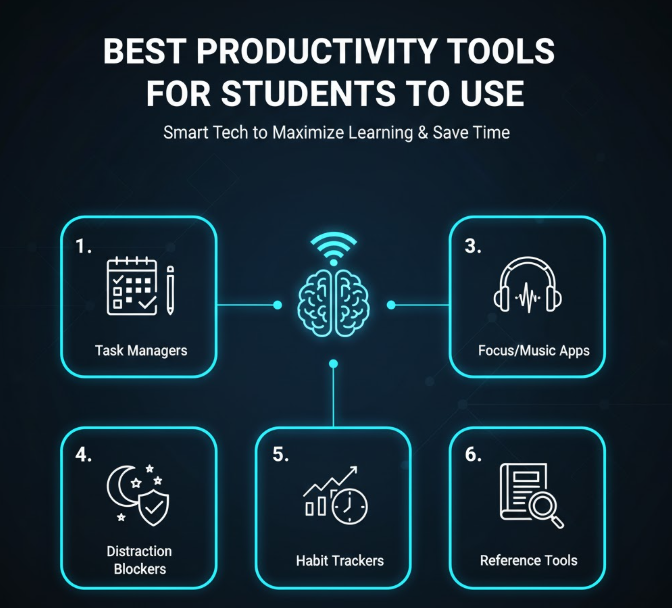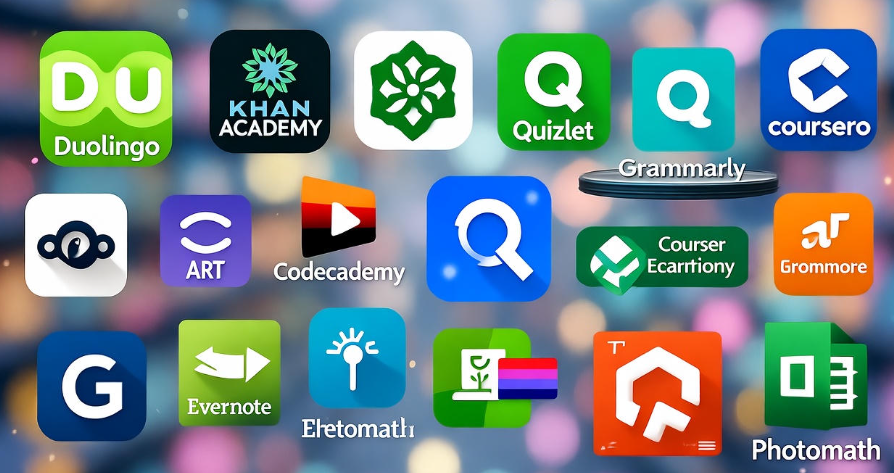You’re managing homework, projects, exams and extra curricular activities—all while trying to balance your social and personal life. When it is exams season students have multiple subjects, deadlines and commitments to juggle; the result can be that they feel stressed and disorganised. The good news? Technology can be something that makes your academic life easier, instead of just a distraction.
Productivity tools are the type of things that help you be better organized with your time, organize your notes, work together on that project with classmates and keep track of everything you have to do. These aren’t complicated programs that take a computer science degree to comprehend — they’re easy-to-use apps and websites that can legitimately change the way you do schoolwork. Whether you’re in middle school, and high school or college—having the right tools can help you work smarter instead of harder.
In this guide, we’ll look at the top productivity tools that students actually use and love. From note-taking apps that do all the work for you to task managers that let you forget about never-ending deadlines, these apps are designed to keep you organized, focused and on track toward achieving your academic goals.
Why Students Need Productivity Tools
Before we do a deep dive into the specific tools, let’s discuss why they are important. For some people, traditional approaches like paper schedules and loose-leaf notes do work, but tools that offer more flexibility with digital options have their own advantages. You can even share your notes from every course with others, so that you can all gain a deeper knowledge of the material and learn more!
Productivity tools also train you to learn skills that will keep on giving. It’s an ability to project manage, plan, and organise things that employers are looking for. By beginning now, you’re not only reshaping your grades: You’re also forming habits that will help you succeed in college and beyond.
Best Note-Taking Apps for Studying
We all know the importance of good note taking in achieving academic success, but let’s face it – traditional note-taking is boring and “old school”. Note-taking apps today make the process more enjoyable, and help you retain information better too.
Notion: Your All-in-One Workspace
https://www.notion.so Students love Notion, they really do. This app is more than a plain note taking tool and it would be your complete academic control centre. You can make pages for each one of your classes, embed videos and images, maintain databases to track assignments and coordinate with study groups.
The heart of Notion is its flexibility. Create quick notes, design complex study guides using templates, or build a personal wiki for your coursework. The interface is block-based, which enables you to simply drag and drop content into place, add toggles to see it when required or hide it away for another time, and format everything exactly as you want.
Notion has a free student plan, with unlimited pages and blocks, that is more than sufficient for most academic use. There is a bit of a learning curve compared with these simpler apps, but chances are you can find myriad YouTube tutorials to get started. After the first step, you’ll think how could I have done without it.
Microsoft OneNote: The Right way to Take Notes, for Digital Notebooks or paper notebooks!
If Notion seems a bit too overwhelming, OneNote could be the best match for you. Microsoft built this app to act like a regular notebook, except it’s all digital. You structure content into notebooks (for example, Biology or History), sections (like chapters or units) and pages (individual lectures or topics).
OneNote is at its best when it’s simplest and most reliable. You can type out notes, make use of a stylus or your finger to draw shapes or charts, snap pictures of whiteboards, capture audio during lectures and even solve math problems within the app. It automatically saves to the cloud, so your notes are always backed-up and available on your phone, tablet or computer.
The app also easily interfaces with other Microsoft products, such as Word and PowerPoint, that many schools already use. Current Offering: It’s available for free to students, which makes it a compelling option if you are looking for robust features without the price of a subscription.
Evernote: Still the Cool Kid, and Growing Up For Good
Evernote is one of the longer-enduring productivity apps, and it’s still popular because it does the basics very well. The app aims to make it easy and fast to capture information, and then find it just as easily later with powerful search features.
And you can clip articles from websites, use your phone camera to scan documents, make check lists and tag notes so you can find related information across multiple notebooks. Evernote search is especially powerful—it can even locate text in images and handwritten notes.
The free version limits you on the number of devices you can sync and the amount you can upload each month, but for many students these restrictions are more than enough. If you’re looking for something simple that “just works,” Evernote is a safe bet.
Task Management Tools That Don’t Just Create More Work
It’s superhumanly impossible to keep up with every assignment, test date, project deadline and extracurricular schedule without one. Task management tools are your external brain, holding all that stuff so you can concentrate on the actual work of getting things done.
Todoist: Light and Mighty Task Tracking
It’s the perfect happy medium between simplicity and power. Adding tasks is as simple as writing a sentence — you can type “Math homework due Friday” and the app will figure out the deadline for you. You can categorize tasks by project (say, distinct classes), prioritize them in different levels, schedule recurring tasks for regular homework and view everything in multiple formats — lists and calendars among them.
The app leverages a concept called “Karma,” which gamifies productivity. You get points for completing tasks and maintaining streaks, which may sound silly but actually helps lots of kids stay consistent. Todoist operates on every possible platform and syncs in zero seconds, which means you can jot down a task on your phone during class and it will be waiting for you when you get home at the computer.
The free version is far from bare bones, but the premium version ($4 per month for students) includes some key additions like reminders and the ability to attach files to tasks.
Google Tasks: Built-In Simplicity
But if you’re already using Google services like Gmail and Google Calendar (which many students do), the product complements both of them in a way you might expect, with no learning curve. The app lives right next to your email, so converting emails from teachers into action items is an effortless click away.
Google Tasks is incredibly simple, almost extremely minimalistic, which means it’s either great or not quite enough depending on what you require. You can make a list, assign to due date and time, have subtasks, but that’s the chunk of it. It has no priority levels, tags and other advanced features.
This is perfect for students who can get intimidated by having too many options. You can concentrate on what is to be done, rather than wasting time arranging the organisation of your work. And it is absolutely free, and already tied into software that you probably use several times a day.
Trello: Visual Project Management
Some people visually think, and that’s where Trello works the best. The app is inspired to a board-and-card system based on Japanese manufacturing methods. You make boards for different areas (for instance, “Fall Semester” or “Science Fair Project”) and then add cards that represent individual tasks.
You move cards across columns as you work — typically, “To Do,” “In Progress” and “Completed.” Add due dates, checklists, attachments, labels to cards — or assign them to different members of the team for group assignments.
Trello is great for projects that are more than one step or working with classmates. Visualizing everything in its place makes the big picture make sense, and you can easily see where attention is needed. The free version is fairly generous for student work; the interface is intuitive enough to understand within minutes.
 Focus and Time Management Solutions
Focus and Time Management Solutions
Knowing what to do and having a list of things to do are two different things. They are tools that can help you to keep your focus, and efficiently manage your time.
Forest: Focus on What Matters, One Session At A Time
Forest is a new way to fight phone distraction creatively. When you want to hunker down, you plant a virtual tree that grows as long as you’re working. Check social media or text friends while outside the app, and your tree will die. Focus successfully for the entire session, and you grow a healthy tree that becomes part of your virtual forest.
This might sound juvenile, but its psychological impact can be potent. No one wants to kill their tree, so you’re motivated to be clear about where your attention is landing. Your forest becomes a visual reflection of your accomplishments over time. The app even collaborates with a real-life tree-planting company, which means that your virtual focus sessions can result in trees being planted for real.
Forest will cost you a couple of dollars, but there’s no subscription. It functions on both phones and computers, helping you stay focused whether you’re studying at your desk or in the library.
Pomodoro Timer Apps: The 25-Minute Secret
Pomodoro Technique is a time management technique where you work in focused 25-minute blocks with five minute rest in between those periods. After four sessions, you get a longer break: 15 to 30 minutes. It is a way to avoid burn out and keep your focus up.
There are dozens of free Pomodoro timer apps, like Focus Booster, Pomofocus and Be Focused. They all pretty much do the same thing — track your work sessions and breaks, which you can customize if 25 minutes doesn’t work for you.
How these timers are helpful is that they divide intimidating jobs into more manageable pieces. Instead of “I need to study for three hours,” it’s “four twenty-five-minute Pomodoro sessions.” The time commitment is not so intimidating, and it’s easier to start working.
RescueTime: Understanding Your Digital Habits
What you cannot measure, you can’t improve. Background in your devices, it logs everything you do online. At the end of each day or week, you’ll get a detailed report that shows which websites and apps were sucking away your attention.
The results are often eye-opening. You may believe that you dedicated an hour to homework, but in reality sat on social media for 40 minutes and worked for only 20.
The app will also block distracting websites during periods you set it for focused work. The free version delivers lots of valuable insights, and the premium version ($12/month) offers more detailed reports and productivity scores.
Study and Learning Enhancement Tools
These are the types of tools that can assist you in learning material more efficiently and with examination preparation.
Quizlet: Flashcards Reimagined
Quizlet has been a popular study app for years, and it has only gotten better. You can create your own digital flashcards or pull from millions of study sets created by other students and teachers. As long as you are looking for basic flash cards, Quizlet has a number of study modes that can help you learn by playing games such as matching games or practice tests, or offer learning mode which changes based on what you already know and what needs more attention.
The app employs spaced repetition, a scientifically proven practice of reviewing information at expanding intervals in order to commit it to long-term memory. Quizlet automatically schedules reviews, adjusting to how well you know each card.
You can study on any device, share study sets with classmates and view them offline or learn using diagrams for subjects like anatomy or geography. The free version is robust enough, but Quizlet Plus ($7.99 a month or $35.99 a year for students) removes ads and has offline access.
Anki: For Serious Memorization
If Quizlet isn’t intense enough for you, Anki is the flashcard app of choice for medical students and language learners. It has a more advanced spaced repetition algorithm and can be highly customized.
Anki is free on computers and Android, but the iOS app costs $25 (a one-time purchase). The interface isn’t as sleek as Quizlet, and there’s a bit of a steeper learning curve, but memorization results are vastly better for anyone willing to put in the time.
And students who are studying for big tests like the SAT, or an AP exam, or even just a Spanish language proficiency test swear by Anki. If you need to be able to remember high volumes of information with reliability, it’s worth the time investment.
Collaboration and Communication Platforms
Group work doesn’t have to be a hot mess. These are tools that can make it productive to work with classmates.
Google Workspace: The Student Standard
Most schools offer free Google Workspace (formerly G Suite) accounts, including the ability to use Google Docs, Sheets, Slides and Drive. It’s no wonder — these tools have become the go-to for student collaboration.
Several people can collaborate on the one document at once and watch each other’s changes happen in real-time. You can leave comments and suggestions, and track revisions if you need to know what changed. Everything is automatically saved to the cloud, so you don’t have to worry about losing work.
Google Drive provides 15GB of free space to keep all your files in the cloud and you can share folders with group members, ensuring that everyone has access to project material. Even for the non-technical, the interface is intuitive and easy to use, so contribution is accessible to everyone.
Slack: Better Than Group Texts
Group text threads become monstrous and information gets lost in the process. Slack is an easier way to talk to study groups, project teams, work conversations, you name it.
You make channels for topics (#general, #homework-help, #project-ideas), keeping conversations neat. You can share files, make polls, search through old messages for that link that someone shared weeks ago and even integrate other tools like Google Drive or Trello.
Slack functions on phones, tablets and computers, offering notifications you can tailor so you’re not always interrupted. The free version saves messages from the most recent 90 days, a batch sufficient for semester-long courses.
Reference Management and Research Tools
Most essays need to cite sources, and these products make it a whole lot simpler.
Zotero: Citation Management Made Simple
Zotero is a free tool that helps you collect, organize, and cite your research sources. Install the browser extension and you can bookmark posts, books or sites with a single click. When you use Zotero, citation information such as author names, publication date and title is automatically extracted.
When you’re writing papers, Zotero works with Microsoft Word and Google Docs to insert citations and create bibliographies according to the format your teacher wants (MLA, APA, Chicago style and so on). Just this will save me hours of drudge work formatting.
You can even add notes and tags, organize sources into collections for separate papers and annotate PDFs. All of that is synchronizable across devices with a free account.
Grammarly: Your Writing Assistant
Grammarly does more than just spell-check to point out grammar mistakes, suggest better word choices and even analyze your writing tone. The free browser extension functions in nearly any text field online, including Google Docs, email and social media.
The tool offers explanations for its suggestions, so in theory it helps you learn from your mistakes and not just fix them. And, as time goes by you will get a hang of the patterning in your writing and make lesser mistakes on a gradual process.
The free version catches most problems, but Grammarly Premium ($12/month with student discounts) includes advanced checks for clarity, tone and plagiarism detection. The free version is more than enough for many students.
Comparison Table: Match Them Up!
| Category | Best for Beginners | Best for Power Users | Best Free Option |
|---|---|---|---|
| Note-Taking | OneNote | Notion | OneNote |
| Task Management | Google Tasks | Todoist Premium | Todoist Free |
| Focus/Time Management | Forest | RescueTime Premium | Pomofocus |
| Flashcards/Study | Quizlet | Anki | Quizlet |
| Collaboration | Google Workspace | Slack Premium | Google Workspace |
| Citation Management | EasyBib | Zotero | Zotero |
Building Your Personal Productivity System
With all the tools at your disposal you might feel compelled to use them all. Don’t. You can become a victim of tool overload – spending more time managing your productivity system than actually getting things done.
Begin with just two or three tools that help you so your biggest problems. If you chronically forget assignments, start with a to-do app. If you need to better organize your notes, look in the direction of good notes app. If you find yourself slipping, use a Pomodoro timer.
Use each tool devotedly for two weeks minimum before you add in another. That gives you time to form habits and find out if a tool does indeed work for your own personal style. You won’t fall in love with every popular app, and that’s fine. The best productivity tool is the one you will use consistently.
Bear in mind tools should work for you, not vice versa. If it feels like something is causing more work than progress, ditch it and explore another avenue. The point is to make your life easier, not to become a tool for productivity.
Finding Tools That Will Work in the School System
Most schools operate through learning management systems (LMS) such as Google Classroom, Canvas, Schoology or Blackboard. Your productivity tools should add to that system, not replace it.
A lot of the tools plug into popular learning platforms. You might integrate Google Calendar to pull in assignment due dates automatically for use with Canvas, or take advantage of Notion’s web clipper to save important school announcements from your portal.
Before paying for tools, see what your school already has in place. A lot of schools provide free, premium access to things like Microsoft Office or Adobe Creative Cloud (or some other kind of specialized tool) through education licenses. Your student email could grant you access to features or discounts that you didn’t know were available.
Privacy and Digital Wellness Considerations
Remember privacy settings and data policies when using productivity apps. As the saying goes, if you’re not paying for the product, you are the product, and free tools make money by selling your data or displaying ads. Read privacy policies (or at least skim them) and use settings to opt out of as much data collection as you can.
Remember, as well, to think of the irony of apps meant to make one more productive. The same device filled with apps that can be useful contains limitless distractions. Consider these strategies:
- Silence distracting notifications while you are studying.
- Leverage app time limits in iOS and Android
- Put your phone in another room when you’re engaging in deep work
- Install Website Blockers For Blocking Sites During Focus Time
- Designate time for checking social media unlike 24/7
The ultimate productivity system includes intentional breaks and downtime. Tools should allow you to work efficiently so that you have more time for rest, hobbies and socializing — not cram more work into every free moment.
For more tips on effective study habits and time management techniques, visit Khan Academy’s College Admissions Guide.
 Frequently Asked Questions
Frequently Asked Questions
What is the one most effective productivity tool for high school students?
There is no such thing as a single “best” tool, since everyone’s needs are unique, but Google Workspace (Docs, Sheets, Calendar and Drive) is the best all-around starting set. It’s free, is available everywhere, does most of what students need and you’ve probably been given access with your school email account. Then you would add a task manager like Todoist and something that helps you focus on your work (and keeps you off the phone, while we’re at it?) like Forest to complete your productivity system.
Do I need to spend money on productivity apps premium editions?
Start with free versions first. Many tools have generous free tiers that are perfectly adequate for students. Only upgrade to a paid version if you’ve consistently used the free version for a month and can point to specific premium features that will improve your experience. Student discounts can easily discount premium versions to being very affordable if you do upgrade.
And then how do I remember to actually use all these productivity tools?
Incorporate the use of tools as part of your daily life. For instance, set aside five minutes each morning to look over your list of tasks, and another five minutes each evening to prepare for the next day. Set phone reminders if needed. The secret is consistency — you don’t do it now and then, but take a little out of yourself all the time.
Do productivity tools actually raise my grades?
Your grades aren’t going to get better just by using some tools—your own effort and comprehension do. But the good tools help you organize that effort in ways that make a difference, helping assure you study the right material, stay on schedule and don’t lose track of your notes. Consider them as supportive equipment that helps you to do better, somewhat akin to an athlete’s good shoes.
What if I find all these choices overwhelming?
That’s completely normal. Start ridiculously tiny — pick just one tool that solves your most pressing problem. Use nothing but that tool for a full two weeks. Then — if you’d like 🙂 — add a third tool. Creating a productivity system is something that happens over time, not overnight. Simple systems always beat sophisticated systems that make you draw an environment around them.
Is handwriting better than typing notes?
Research shows mixed results. Some studies indicate that handwriting enhances retention, in part because it slows you down and prompts you to process information rather than merely dictating or typing it verbatim. But digital notes have the advantages of being searchable, easily grouped and backed up, things paper can’t match. For a more hybrid approach, many students handwrite their early notes for better learning and later organize (and reinforce) them digitally for studying. Experiment with what suits your brain.
Wrapping Up Your Productivity Journey
The productivity tools we’ve discussed in this guide, which range from robust note-takers such as Notion and OneNote to focus apps like Forest and collaboration platforms like Google Workspace, can truly revolutionize your academic experience. But also know that they’re tools, not magic solutions. It doesn’t matter how advanced an app is if you never tap the icon, no more than fancy appliances can whip you into shape if they sit unused.
Begin with something basic, keep it up and tweak it based on what actually works for you. Your ideal productivity system might bear no resemblance to your friend’s system, and that is 100% okay. That said, the key is discovering a few which alleviate stress, aid in keeping you organized and provide additional time to enjoy stuff other than school work.
Technology shouldn’t complicate your student life; it should simplify it! Pick whatever tools come natural, do what works and don’t be afraid to let go of the things that did not. Your productivity system should grow with you, and evolve as your needs and circumstances do. The habits you develop now — organizing information, arranging time, prioritizing tasks — will bring benefits long after your graduation.
Now quit reading about productivity tools and go use one already. Your better organized, less stressed and more successful academic future awaits.





